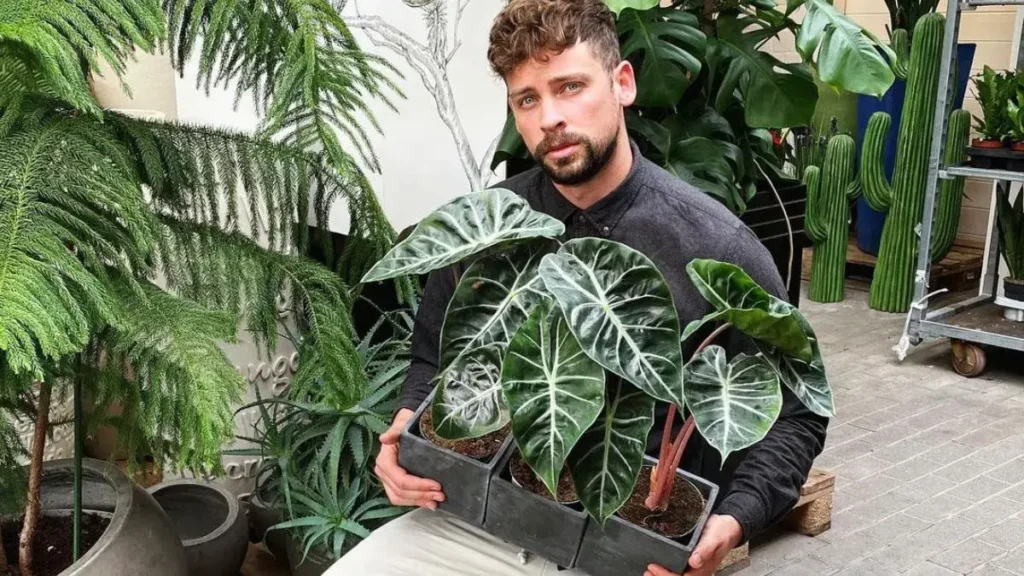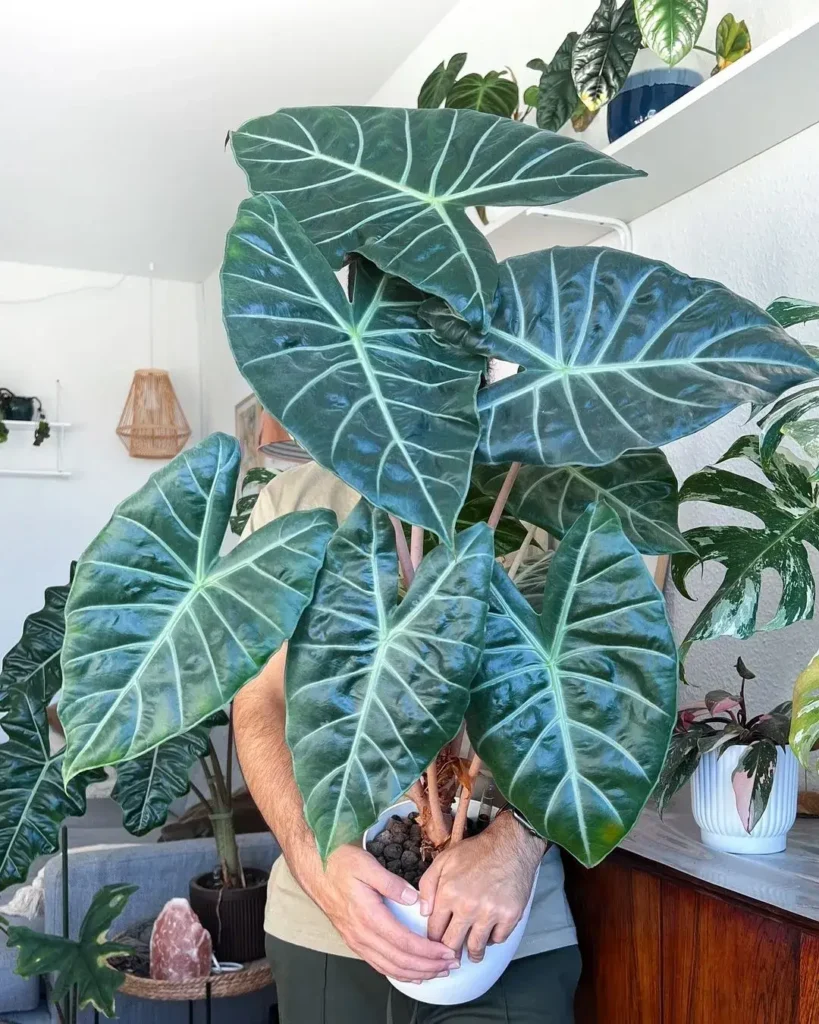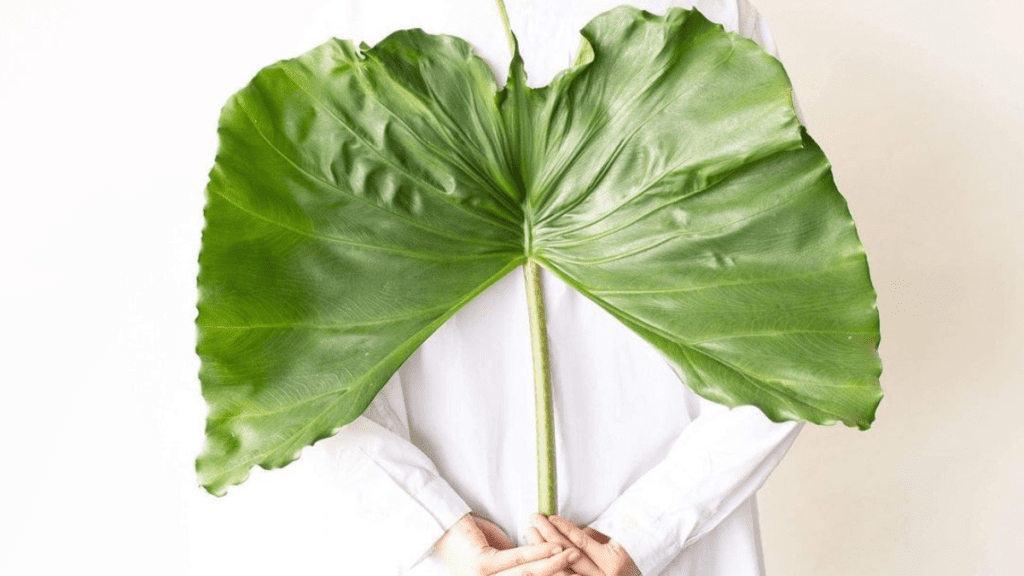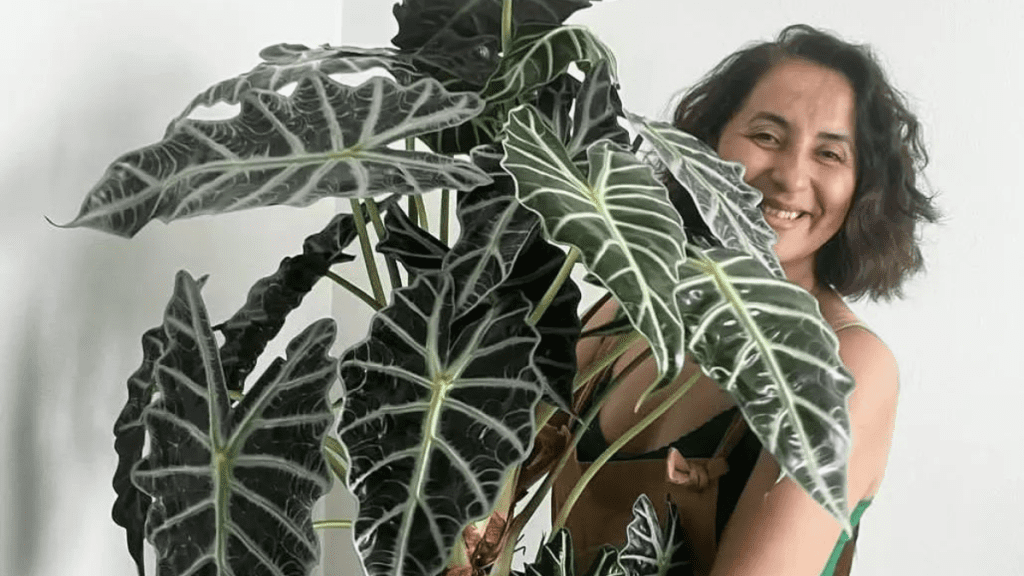
Heyo plant parents, get ready to discover Alocasia Pink Dragon, scientifically known as Alocasia Calidora, it’s a captivating plant with pink stems and stunning green/white veins weaving through its deep green leaves.
Originating from Southeast Asia, it is a larger growing hybrid of Alocasia Odora and Alocasia Gageana. This resilient beauty not only adds a pop of color to your indoor space but also serves as a natural air purifier, making it an ideal addition to any plant enthusiast’s collection.
Creating the Perfect Environment

As you welcome the Alocasia Pink Dragon into your home, it’s essential to familiarize yourself with its unique characteristics and care requirements.
Light Requirements: Alocasia Pink Dragon thrives in bright, indirect light, making it well-suited for locations near a window with filtered sunlight. While it appreciates ample light, direct sunlight can scorch its delicate leaves, so it’s essential to provide gentle, indirect light. Consider placing it near an east or west-facing window where it can receive bright, indirect sunlight throughout the day. If your home lacks sufficient natural light, supplement with a grow light to ensure the plant’s needs are met.
Watering Needs: Maintaining the right moisture balance is crucial for the health of your Alocasia Pink Dragon. Water the plant when the top inch of the soil feels dry to the touch, ensuring thorough saturation without allowing the soil to become waterlogged. A helpful tip is to use room temperature water to prevent shocking the roots. Always water around the base of the plant, avoiding wetting the foliage, as this can lead to fungal issues. During the growing season (spring and summer), your plant may require more frequent watering, while in the dormant season (fall and winter), reduce watering frequency to prevent overwatering.
Soil Preferences: A well-draining potting mix rich in organic matter is ideal for Alocasia Pink Dragon. Consider a blend of potting soil, perlite, and peat moss to promote proper drainage while retaining moisture—a recipe for happy roots. Regularly check the soil’s moisture level and adjust watering frequency accordingly to prevent waterlogging, which can lead to root rot. Repot your plant every 1-2 years to refresh the soil and provide ample space for root growth.
Temperature and Humidity: Maintain a warm, humid environment to mimic the Alocasia Pink Dragon’s native habitat. Ideally, keep temperatures between 65°F to 80°F (18°C to 27°C) year-round. Avoid exposing the plant to sudden temperature fluctuations or drafts, which can stress the plant. Supplement humidity by misting the plant’s leaves regularly or placing a humidifier nearby. Alternatively, create a humidity tray by filling a shallow tray with pebbles and water, then placing the plant pot on top. As the water evaporates, it increases the ambient humidity around the plant, creating an ideal microclimate.
Care Tip: To prevent dust buildup on the Alocasia Pink Dragon’s leaves, gently wipe them with a damp cloth or sponge every few weeks. This not only keeps the foliage clean but also ensures optimal photosynthesis, allowing the plant to thrive.
Potting and Repotting Guide

Potting: When potting your Alocasia Pink Dragon, choose a container that provides ample room for root growth and has drainage holes at the bottom to prevent waterlogging. Fill the pot with a well-draining potting mix, ensuring that the plant’s roots have enough space to spread out comfortably. Gently remove the plant from its nursery pot and place it in the center of the new container, adding more soil around the sides until the plant is stable. Water thoroughly to settle the soil and remove any air pockets.
Repotting: As your Alocasia Pink Dragon grows, it may outgrow its current pot and require repotting to thrive. Signs that indicate the need for repotting include roots circling the bottom of the pot, soil drying out quickly after watering, or the plant becoming root-bound. When repotting, choose a container that is 1-2 inches larger in diameter than the current pot to accommodate the plant’s growing roots. Gently loosen the roots and remove any old, compacted soil before placing the plant in its new pot with fresh potting mix. Water thoroughly after repotting to help the plant settle into its new home.
Care Tip: To encourage healthy root growth and prevent root rot, consider adding a layer of gravel or small stones at the bottom of the pot before adding soil. This helps improve drainage and prevents water from pooling at the bottom of the pot, reducing the risk of overwatering. Additionally, avoid placing the plant directly on a saucer filled with water, as this can lead to waterlogged soil and root rot over time.
Alocasia Pink Dragon Propagation

Propagation Methods: Propagating your Alocasia Pink Dragon allows you to expand your plant collection or share its beauty with friends and family. There are several methods you can use to propagate this stunning plant, including division, offsets, and stem cuttings.
Division:
When your Alocasia Pink Dragon has grown large enough, you can divide it into smaller sections to create new plants.
Advantages:
- Allows for the creation of multiple plants from a single parent plant.
- Established divisions often have a head start in growth compared to other propagation methods.
Disadvantages:
- Requires a mature plant with well-developed rhizomes or tubers.
- Can potentially damage the parent plant if not done carefully.
Here’s how to do it:
- Carefully remove the plant from its pot, taking care not to damage the roots.
- Gently separate the rhizomes or tubers into smaller sections, ensuring that each division has both roots and foliage.
- Plant the divisions in individual pots filled with well-draining potting mix.
- Water thoroughly to encourage root establishment, and place the newly potted divisions in a location with bright, indirect light.
Offsets:
Another method of propagating Alocasia Pink Dragon is by using offsets, which are small plantlets that grow from the base of the parent plant.
Advantages:
- Offsets are readily available on mature plants and can be propagated without harming the parent plant.
- Often produce new plants quickly with minimal effort.
Disadvantages:
- Not all plants produce offsets, limiting the propagation opportunities.
- Offsets may take some time to establish and grow into mature plants.
Here’s how to propagate using offsets:
- Gently remove the offsets from the parent plant, ensuring that each offset has roots attached.
- Plant the offsets in their own pots filled with potting mix, making sure to bury the roots but keep the leaves above the soil surface.
- Water regularly to promote healthy growth, and provide bright, indirect light to encourage root development.
Stem Cuttings:
Stem cuttings are another effective way to propagate Alocasia Pink Dragon.
Advantages:
- Allows for propagation even from younger plants that may not have developed rhizomes or offsets.
- Provides more control over the number of plants produced and the timing of propagation.
Disadvantages:
- Cuttings may take longer to establish roots and grow into mature plants compared to other propagation methods.
- Requires careful monitoring of moisture levels and environmental conditions to prevent rotting or drying out of the cutting.
Here’s how to propagate using stem cuttings:
- Using a sharp, clean knife or scissors, cut a healthy stem from the parent plant, ensuring that it has at least one node and several leaves attached.
- Dip the cut end of the stem in rooting hormone to encourage root development.
- Plant the cutting in a pot filled with moist potting mix, burying the node and leaving the leaves above the soil surface.
- Keep the soil consistently moist and provide bright, indirect light to promote root growth.
- Optionally, place the pot in a clear plastic bag or cover it with a plastic dome to create a humid environment, which helps prevent moisture loss from the cutting and encourages root development.
- Check the soil moisture regularly and mist the cutting if necessary to maintain humidity levels.
Pest and Disease Management

Common Pests: Despite its resilience, the Alocasia Pink Dragon is susceptible to pests that can compromise its health and beauty. Among the most common pests are mealybugs, spider mites, and scale insects. These pests can feed on the plant’s foliage, weakening it and causing stunted growth or yellowing leaves.
Prevention and Treatment: Regularly inspect your Alocasia Pink Dragon for signs of pest infestation, such as tiny webs, cottony masses, or sticky residue on the leaves. To prevent pests from taking hold, maintain good plant hygiene by regularly cleaning the leaves with a damp cloth or sponge to remove dust and debris. Additionally, avoid overwatering and ensure proper air circulation around the plant to discourage pest infestations.
If you notice signs of pests on your Alocasia Pink Dragon, prompt action is essential to prevent further damage. Treat affected plants with insecticidal soap or neem oil, applying it directly to the affected areas according to the product instructions. For severe infestations, you may need to repeat the treatment every few weeks until the pests are eradicated.
Care Tip: To prevent the spread of pests to other plants in your collection, isolate any infested Alocasia Pink Dragon plants and treat them separately. Inspect nearby plants for signs of pest activity and take preventive measures to protect them from infestation.
Pruning and Grooming Tips

Maintaining Optimal Shape: Pruning is an essential aspect of Alocasia Pink Dragon care, helping to maintain its optimal shape and promote healthy growth. Regularly inspect your plant for dead, damaged, or yellowing leaves, as well as any overgrown or leggy stems. Pruning these parts not only improves the plant’s appearance but also redirects energy to new growth, ensuring vitality.
Pruning Techniques: When pruning your Alocasia Pink Dragon, use sharp, clean scissors or pruning shears to make clean cuts. Remove dead or yellowing leaves at the base of the stem, taking care not to damage surrounding foliage. For overgrown stems, trim them back to a healthy node or leaf to encourage branching and bushier growth.
Grooming Practices: In addition to pruning, grooming your Alocasia Pink Dragon involves removing dust and debris from the leaves to maintain optimal photosynthesis. Gently wipe the leaves with a damp cloth or sponge regularly to remove dust buildup, paying attention to both the upper and lower leaf surfaces. This not only keeps the foliage clean but also prevents pests from taking hold.
Care Tip: After pruning or grooming your Alocasia Pink Dragon, apply a thin layer of neem oil or leaf shine to the leaves to provide protection and enhance their natural luster. This helps prevent pests and diseases while giving your plant a glossy, polished appearance.
Seasonal Care Guide

Adjusting to Changing Seasons: As the seasons change, so do the needs of your Alocasia Pink Dragon. Understanding how to adapt your care routine to accommodate seasonal fluctuations is essential for maintaining the health and vitality of your plant year-round.
Spring and Summer: During the warmer months of spring and summer, your Alocasia Pink Dragon experiences a period of active growth. Provide ample sunlight, warmth, and humidity to encourage robust foliage development. Increase watering frequency to keep the soil consistently moist, but take care not to overwater, as this can lead to root rot. Regularly inspect your plant for signs of pests and diseases, and take prompt action to address any issues.
Fall and Winter: As temperatures cool and daylight hours decrease in fall and winter, your Alocasia Pink Dragon enters a period of dormancy. Reduce watering frequency to allow the soil to dry out slightly between waterings, as the plant’s growth slows during this time. Protect your plant from cold drafts and temperature fluctuations by keeping it away from windows and heating vents. Consider moving your plant to a warmer location or using a grow light to supplement natural light if necessary.
Seasonal Transitions: During seasonal transitions, such as the shift from winter to spring or summer to fall, gradually adjust your care routine to accommodate changing environmental conditions. Monitor your plant closely for signs of stress or adjustment, such as wilting or yellowing leaves, and make necessary adjustments to ensure its continued well-being.
Care Tip: To help your Alocasia Pink Dragon transition smoothly between seasons, consider fertilizing with a balanced houseplant fertilizer during the growing season to provide essential nutrients for healthy growth. Dilute the fertilizer to half strength to avoid over-fertilizing, and apply it according to the product instructions.
Decorating with Alocasia Pink Dragon

Indoor Décor Ideas: The Alocasia Pink Dragon isn’t just a plant; it’s a statement piece that adds a touch of exotic elegance to any indoor space. Incorporate this stunning plant into your home décor to create a vibrant and inviting atmosphere.
Solo Showcase: Let your Alocasia Pink Dragon take center stage by placing it in a decorative pot or planter and placing it on a pedestal or stand in a prominent location. Choose a pot that complements your décor style and showcases the plant’s beauty, such as a sleek ceramic pot or a rustic terracotta planter.
Group Plantings: For a dynamic display, group your Alocasia Pink Dragon with other houseplants of varying heights, textures, and colors. Create a mini indoor jungle by combining it with plants like Monstera, Bird of Paradise, or Pothos to add depth and visual interest to your space.
Vertical Gardens: Take your indoor gardening to new heights by incorporating your Alocasia Pink Dragon into a vertical garden or living wall. Mount shelves or hanging planters on the wall and arrange your plants vertically to maximize space and create a striking focal point.
Outdoor Oasis: Don’t limit your Alocasia Pink Dragon to indoor spaces—bring it outdoors to create a tropical paradise on your patio or balcony. Pair it with outdoor furniture, colorful cushions, and ambient lighting to create a cozy outdoor retreat where you can relax and unwind.
Care Tip: When decorating with Alocasia Pink Dragon, consider the lighting conditions of your space and choose a location that provides the right balance of bright, indirect light and protection from direct sunlight. Monitor your plant closely for signs of stress, such as wilting or yellowing leaves, and adjust its placement accordingly to ensure its continued health and vitality.
Alocasia Pink Dragon and Air Purification

Natural Air Purification: In addition to its stunning beauty, the Alocasia Pink Dragon also boasts air-purifying qualities that can benefit your indoor environment. Like other plants, it helps remove harmful toxins from the air, improving air quality and creating a healthier living space for you and your family.
Filtering Toxins: The Alocasia Pink Dragon is particularly effective at filtering common indoor air pollutants such as formaldehyde, benzene, and xylene. These toxins can be found in everyday household items such as paints, cleaning products, and furniture, and prolonged exposure to them can have adverse health effects. By introducing this plant into your home, you can help remove these harmful substances and create a cleaner, fresher indoor environment.
Enhancing Respiratory Health: By purifying the air and removing harmful pollutants, the Alocasia Pink Dragon can also help enhance respiratory health and alleviate symptoms of allergies and asthma. Breathing cleaner air can reduce the risk of respiratory issues and improve overall well-being, making this plant a valuable addition to any indoor space.
Care Tip: To maximize the air-purifying benefits of your Alocasia Pink Dragon, place it in areas where you spend the most time, such as the living room or bedroom. Consider grouping it with other air-purifying plants such as peace lilies, spider plants, and snake plants to create a natural air purification system that works synergistically to cleanse the air in your home.
If you’re thinking of extending your alocasia family, I recommend reading up on alocasia hilo beauty and alocasia cucullata (hooded dwarf elephant ear). They would both make great additions to your squad!
Conclusion
If you’re seeking to enrich your indoor environment, the Alocasia Pink Dragon offers aesthetic allure with practical benefits like air purification and stress reduction.
By nurturing this captivating plant with care and attention, you can cultivate a flourishing sanctuary that enhances both their physical space and their well-being.
FAQ
How often should I fertilize my Alocasia Pink Dragon?
Fertilize your Alocasia Pink Dragon every 2-4 weeks during the growing season (spring and summer) with a balanced houseplant fertilizer diluted to half strength. Reduce fertilization frequency to once every 6-8 weeks during the dormant season (fall and winter) to avoid over-fertilizing and causing nutrient buildup in the soil.
Why are the leaves of my Alocasia Pink Dragon turning yellow?
Yellowing leaves on an Alocasia Pink Dragon can be a sign of various issues, including overwatering, underwatering, insufficient light, or pest infestation. Evaluate your plant’s care routine and environment to identify and address the underlying cause of leaf yellowing, such as adjusting watering frequency, providing adequate light, or treating for pests.
Can I propagate my Alocasia Pink Dragon in water?
Yes, you can propagate Alocasia Pink Dragon in water by taking stem cuttings and placing them in a container filled with clean, room-temperature water. Change the water every few days to prevent stagnation and monitor the cutting for root development. Once roots have formed, transplant the cutting into a pot with well-draining potting mix to continue its growth.
How do I increase humidity for my Alocasia Pink Dragon?
To increase humidity for your Alocasia Pink Dragon, you can mist the plant’s leaves regularly with water, place a humidifier near the plant, or create a humidity tray by filling a shallow tray with water and pebbles and placing the plant pot on top. These methods help create a humid microclimate around the plant, mimicking its native tropical environment.

Writer/Green Thumb/Explorer – Rooted deep in the rich soils of Devon, I’ve cultivated a vast expertise in plant care, helping greenery thrive in homes across the UK. When I’m not crafting detailed plant care guides, I’m journeying through the lush landscapes of the West Country, unearthing nature’s secrets and sharing them with fellow plant enthusiasts. Every leaf has a story, and I’m here to tell it.




